ハインリヒ・ヒムラーとナチス親衛隊
Heinrich L. Himmler and Schutzstaffel (SS)
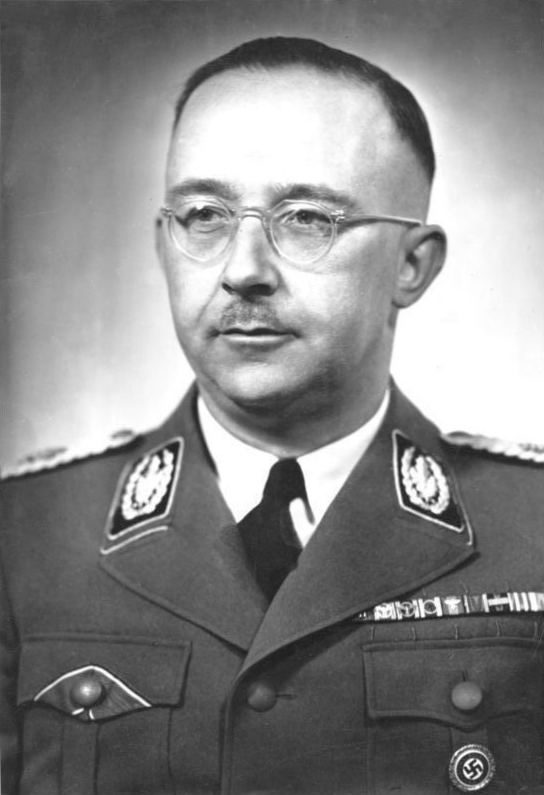 _
_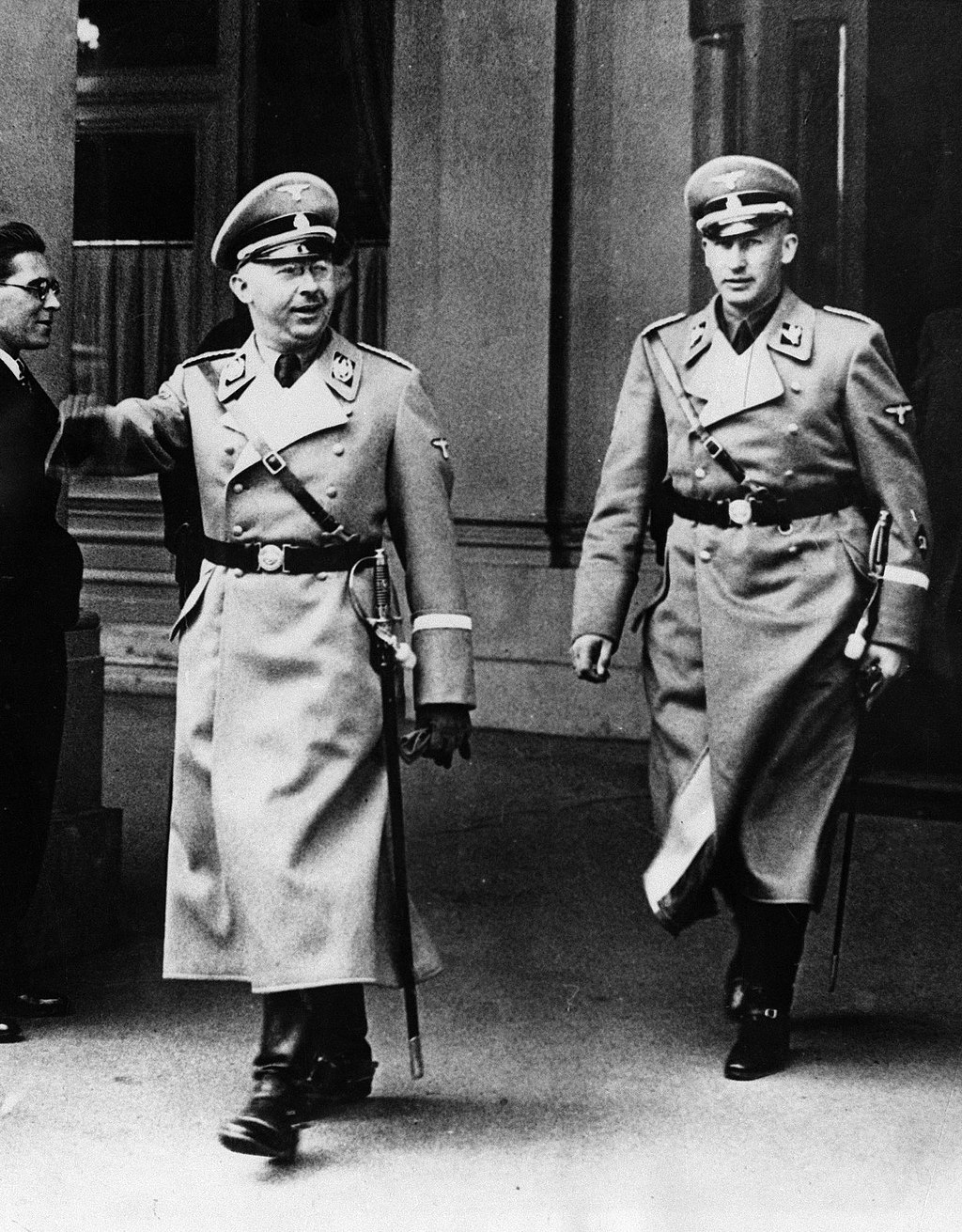 _
_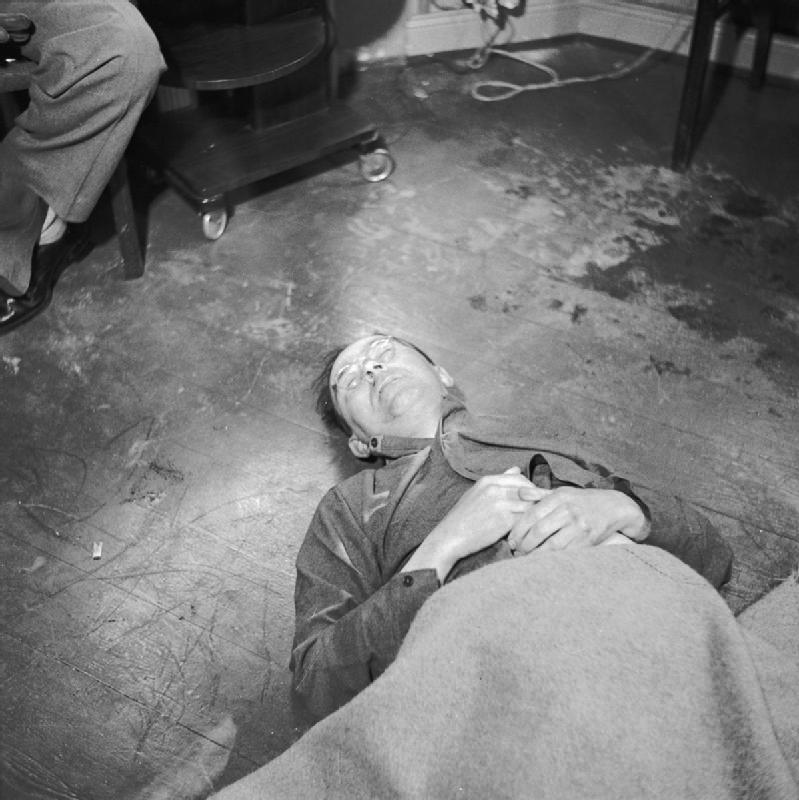
ハインリヒ・ヒムラーとナチス親衛隊
Heinrich L. Himmler and Schutzstaffel (SS)
 _
_ _
_
ハインリヒ・ヒムラーとその最期(ウィ キペディアに よる;Heinrich Himmler):「フレンスブルク政府を放逐されたヒムラーは5月20日に「野戦憲兵曹長ハインリヒ・ヒッツィンガー」として、髭を剃って眼帯 を装着、ルドルフ・ ブラント、カール・ゲプハルトなどの側近たちとともにホルシュタインからエルベ川を超えて逃亡した。5月22日、ブレーマーフェルデとハンブルクの間にあ るバルンシュテット(Barnstedt) 村のはずれでイギリス軍に拘束され、捕虜としてリューネブルクの捕虜収容所に送られた。 ヒムラーは何度も強制収容所を視察し、部下が実際に何をしているかをよく知っており、ユダヤ人迫害等の非人道的な行為ゆえに戦後連合軍から糾弾されること を覚悟していた。そのため、敗戦間近になると部下に、親衛隊の制服を国防軍の軍服に着替え、国防軍に潜り込んで逃亡するように命令していた。これが「忠誠 こそ我が名誉」と若き親衛隊員を導いた親衛隊全国指導者の最後の命令となった。 ヒムラーは、イギリス軍の一兵卒の捕虜への粗末な扱いに耐えられなくなり、収容所所 長に対して「私はハインリヒ・ヒムラーだ」と名乗った。さらに連合軍上層部との政治的交渉を求めた。所長は上層部に取り計らってみると回答 したが、結局交渉は拒否された。翌5月23日、ヒムラーの身体検査が行われた。イギ リス軍のエドウィン・オースティン曹長がヒムラーに長椅子を指して「これがあなたの寝台だ。服を脱ぎなさい」と全裸になることを要求したが、これに対して ヒムラーは「君は私が誰だか分かっているのかね」などと述べた。オースティンは「あなたはハインリヒ・ヒムラーだ。そしてこれがあなたの寝台だ。服を脱ぎ なさい」と再度全裸になることを要求した。ヒムラーとオースティンはしばらくじっと睨みあっていたが、先に目を逸らしたのはヒムラーの方だった。彼はおと なしく服を脱ぎはじめた。軍医がヒムラーの身体を調べ、口の中を調べようと指を入れた時、ヒムラーは軍医の指にかみついた。そして奥歯に隠し持っていたシ アン化カリウムのカプセルを噛み砕き倒れた。その場にいたイギリス軍兵士たちはすぐにヒムラーの身体を逆さにして毒を吐き出させようとし た。ついで糸と針で舌を固定して催吐剤を使用して胃液を吐きださせようとしたが、約12分間苦しんだ後に死亡した。自殺を防げなかった軍医は直後に「やら れた」と口にしたという。イギリス軍はヒムラーの遺体の写真を撮り、さらにデスマス クを作った後、彼の頭を切開して脳の一片を切り取って保存した[グイド・クノップ『ヒトラーの共犯者 12人の側近たち』上、高木玲訳、原書房、2001年]。 遺体は1日放置され、イギリス軍の報告を受けて到着したアメリカ軍とソ連軍の士官の検死を受けた後、リューネブルクの森に埋められた。埋葬後に墓石等は与 えられなかったため、森のどこに埋められているのかは不明」逃亡と死.
★ヒムラー伝 https://en.wikipedia.org/wiki/Heinrich_Himmler の翻訳はこちらです「ハインリヒ・ヒムラー」
●Schutzstaffel (SS)の歴史(ウィキペディアに よる)用語法については"Glossary of Nazi Germany"を参照してください。
1920-1933 政権獲得まで闘争時代は、反対 政党に対する武闘組織として突撃隊 (SA) があった
1923 3月にヒトラー個人のボディガードとして の「司令部護衛隊(Stabswache)」が創設された。1923年5月に「アドルフ・ヒトラー特攻隊 (Stoßtrupp Adolf Hitler)」に改組
1924 2月25日にナチ党に対する非常事態宣言 の解除。2日後に再結党宣言。
1925 4月中旬にユリウス・シュレックに自らの 警護部隊を再建するようヒトラーは命じた。2週間後の5月にこの組織は「親衛隊 (Schutzstaffel)」の名前を与えられた。
1926
4月にベルヒトルトが亡命先のオーストリアから帰国 してシュレックから親衛隊隊長の職を受け継いだ。11月1日にフランツ・プフェファー・フォン・ザロモンが突撃隊最高指導者に任じられたのを機に親衛隊は 突撃隊の傘下に組み入れられ、同時にベルヒトルトは「親衛隊全国指導者」(Reichsführer-SS)の肩書を得た
1927 3月にベルヒトルトの副官エアハルト・ハ イデンが代わって親衛隊全国指導者に就任。
1929
1月6日にハイデンの副官であったハインリヒ・ヒム ラーが第4代親衛隊全国指導者に任じられた。ヴァルター・ダレの『血と大地』のイデオロギーに強く影響されていたヒムラーは、1929年4月に親衛隊の組 織規定の草案をヒトラーやフォン・ザロモンに提出し、人種的な問題を親衛隊入隊の条件に据えるようになった
1930
11月7日付けの命令で正式に親衛隊を党内警察組織 と規定した。7月にクルト・ダリューゲが親衛隊に参加した。ダリューゲは親衛隊に入る前からベルリン親衛隊をヒムラーから独立して指揮することをヒトラー から認められていた人物で、親衛隊移籍後にもベルリン親衛隊をヒムラーから事実上独立して指揮していた
1931
6月には海軍を追放され失業中だったラインハルト・
ハイドリヒが親衛隊に参加した。ヒムラーはこのハイドリヒに親衛隊の諜報部「IC課」を任せた。1932年7月にこの組織はSDに改組された。SDは後に
全ヨーロッパに監視の目を張り巡らせる巨大諜報機関に成長するが、設立当初はハイドリヒの妻リナが秘書を務め、彼の部下は3人だけという状態であった
1932
1月25日にはミュンヘンの党本部「褐色館」の警備
の全権がヒムラーに任せられた。7月7日にはこれまでの突撃隊と同型の制服を改めて親衛隊独自の制服が制定された。これが親衛隊の制服として有名な「黒
服」
1933
1月30日にヒトラーはパウル・フォン・ヒンデンブ ルク大統領からドイツ国首相に任命されてドイツの政権を掌握。党幹部が次々と政府や州政府の要職に就任したが、ヒムラーとハイドリヒには何のポストも与え られず、彼らはミュンヘンにとどまっていた。3月9日にハインリヒ・ヘルトが首相を務めるバイエルン州政府がフランツ・フォン・エップ率いる党部隊に制圧 されるとようやくヒムラーがミュンヘン警察長官、ハイドリヒがミュンヘン警察政治局長に任命された[60][61]。さらに4月にはヒムラーがバイエルン 州警察長官、ハイドリヒがバイエルン州政治警察部長となった
1933-1934 強制的同一化(Gleichschaltung) と併せて各州の政治警察がヒムラーに任せられていったが、ドイツの国土の大半を占めるプロイセン州の警察は相変わらず、ゲーリングやディールス、ダリュー ゲらによって支配され続けた。
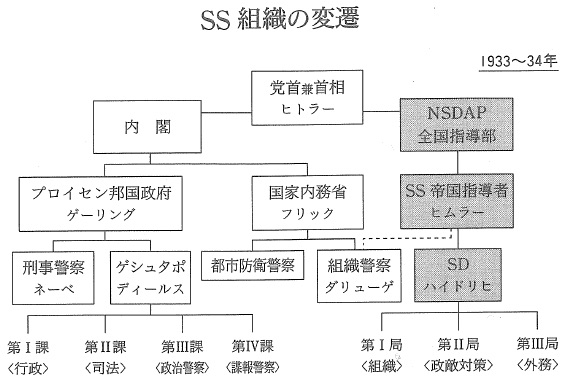
1934
ゲーリングは、4月20日、ディールスが務めるゲ シュタポ局長の上位職として「ゲシュタポ総監兼長官代理(Inspekteur und stellvertretender Chef des Geheimen Staatspolizeiamtes)」を新設し、ヒムラーをこれに任じた。ヒムラーはハイドリヒをゲシュタポ局長に任じた。7月20日に親衛隊は突撃 隊から分離、独立を果たした。1933年の政権獲得後ドイツ各地に建てられた敵性分子を収容する強制収容所(KZ)の監督権もすべて親衛隊に移された。ヒ ムラーはダッハウ強制収容所所長テオドール・アイケを強制収容所総監に任じた。アイケは1933年末にダッハウ強制収容所の監視部隊を親衛隊髑髏部隊とし て組織しており、長いナイフの夜事件の際にも粛清の実行部隊として活躍し、事件後には五個大隊に再編されて各強制収容所に警備部隊として配置されるように なった。
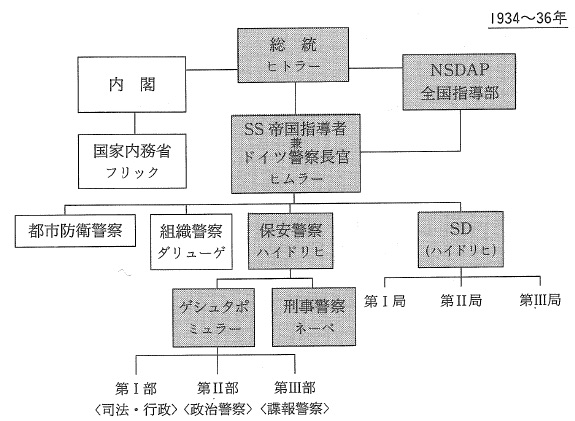
1936 6月17日にはフリックはヒムラーを全ド イツ警察長官に任じる。
1937
11月13日にヒムラーは「親衛隊及び警察高級指導 者(Höherer SS- und Polizeiführer、略称HSSPF)」の職を新設した。彼らはヒムラーの親衛隊全国指導者と全ドイツ警察長官の地位を代行する者としてドイツ国 内や占領地の各地に配置されていく。

1939 (→1939年以降のナチス親衛隊)
9月、ハイドリヒは政治警察活動の重複を避けるため に党機関であるSDと国家機関である保安警察を一つの傘の下に束ねた。それが親衛隊の国家保安本部である。SDは第III局(SD国内諜報)とVI局 (SD国外諜報)に、秘密警察(ゲシュタポ)は第IV局に、刑事警察は第V局に配置された。III局はオットー・オーレンドルフ親衛隊中将、IV局は「ゲ シュタポ・ミュラー」と呼ばれたハインリヒ・ミュラー親衛隊中将、V局はアルトゥール・ネーベ親衛隊中将、VI局は30歳で親衛隊少将兼警察少将となった ヴァルター・シェレンベルクが指揮した。第二次世界大戦後期には国防軍の諜報部であったはずのアプヴェーアが国家保安本部VI局に組み込まれ、ドイツの対 外諜報活動はすべて国家保安本部が管轄するところとなった。
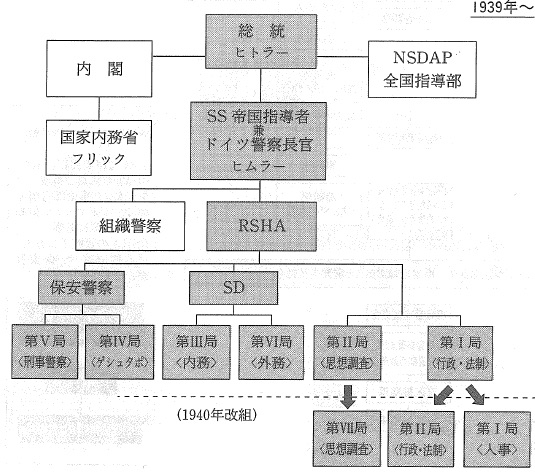
1942
1月にはハ イドリヒがヴァンゼー会議を開催し、ラインハルト作戦を策定してベウジェツ強制収容所、ソビボル強制収容所、トレブリンカ強制収容所などの絶滅収容所を建 設し、ヨーロッパのユダヤ人の絶滅を目指す。東部戦線ではアインザッツグルッペンを組織して、ゲリラ掃討の名目でユダヤ人や一般市民の虐殺を行う。
6月にエンスラポイド作戦でハイドリヒが暗殺される とヒムラーが国家保安本部長官を兼務するようになったが(この間はI局局長ブルーノ・シュトレッケンバッハが長官代理として実務を取り仕切る)
1943 1月からはエルンスト・カルテンブルン ナーが後任に任じられて国家保安本部長官
1944
7月20日のヒトラー暗殺未遂事件の際にも親衛隊と 国家保安本部は最大の鎮圧者として活躍した。戦況が悪化していくにつれて親衛隊や国家保安本部の秘密警察権力は肥大化し、ゲシュタポの暴走を止めるにはヒ トラーさえも苦労を要するようになった
SSの組織図はすべて、ヘーネ、ハインツ『SSの歴 史(上)』森亮一訳、Pp.504-507 、講談社、2001年による
1945
4月30日にナチス・ドイツ総統アドルフ・ヒトラー は総統地下壕で自殺。5月4日は「西部戦線降伏の日」となり、ハンス=ゲオルク・フォン・フリーデブルク海軍大将がオランダ・デンマーク・北ドイツの全艦 艇が無条件降伏し、5月5日午前8時(英国夏時間)に停戦する文書に調印。5月7日0時15分、ヨードルの連絡を受けたデーニッツはドイツ軍全軍の降伏を 決意し、ドイツ国防軍最高司令部長官ヴィルヘルム・カイテル元帥名でヨードルに降伏文書調印の権限を与えた。また同時に西方総軍とその指揮下にある中部軍 集団、南部軍集団、E軍集団に対して西への脱出を命令した。6月5日には連合国軍によってベルリン宣言が発令され、ドイツの中央政府消滅と米英仏ソ四国に よる主権掌握が発表された。しかし1948年に西側連合国占領区域ではドイツ連邦共和国(西ドイツ)、ソ連占領地域ではドイツ民主共和国(東ドイツ)が発 足した。

ヴィルヘルム・カイテル(Wilhelm Bodewin Johann Gustav Keitel, 1882-1946)
★ヒムラー伝 https://en.wikipedia.org/wiki/Heinrich_Himmler
はこちらです「ハインリヒ・ヒムラー」
●SSと経済活動
「ヒムラーは党の政権獲得前から親衛隊の後援会員
(FM)の拡大を目指していた。後援会員は親衛隊に資金を提供するが加入はしないシンパのメンバーである。親衛隊の各連隊はそれぞれの後援会を所持してお
り、隊員には少なくとも一人の後援会員を確保することが命じられていた。1932年の時点では後援会員数は1万3000人にとどまっているが、政権獲得後
に一気に後援会員数が増大し、1933年には16万7000人まで伸ばし、さらに1934年には34万2000人に達した[76]。1932年夏にヒト
ラーの経済顧問ヴィルヘルム・ケプラー(Wilhelm
Keppler)が創設した「経済問題研究委員会」は、1934年半ばに親衛隊に取り込まれて「親衛隊全国指導者友の会(Freundeskreis
Reichsführer SS)」となったが、これは親衛隊の後援会の中でも頂点に位置するものであった。ここにはIGファルベンの
幹部ハインリヒ・ビューテフィシュ(Heinrich Bütefisch)、大財閥フリックのフリードリヒ・フリック(Friedrich
Flick)、大手食品会社ドクター・エトカーのリヒャルト・カゼロウスキー(Richard
Kaselowsky)、ドレスナー銀行のエミール・ハインリヒ・マイヤー(Emil Heinrich
Meyer)、ドイツ銀行のカール・リッター・フォン・ハルト(Karl Ritter von
Halt)、ジーメンス・シュケルトのルドルフ・ビンゲル (Rudolf Bingel)、J.H.シュタイン銀行(J. H. Stein
Bank)のクルト・フォン・シュレーダー男爵(Kurt Freiherr von
Schröder)、国営企業ヘルマン・ゲーリング(Reichswerke Hermann Göring)のヴィルヘルム・フォス(Wilhelm
Voss)などそうそうたる財界重鎮が集まった。後援会員はヒトラーへの宣誓も義務付けられず、親衛隊から命令を受けることも制服の着用義務もなく、金銭
面のみで親衛隊とつながった人々だった。しかし親衛隊の間違いのない財源であり、重要な存在であった[77]。ヒムラーは後援会員にもしばしば親衛隊名誉
指導者として親衛隊の階級を与えるようになった。これにより親衛隊に「親衛隊の魂」を持たぬ者が大量に流れ込むこととなり、旧来からの隊員たちを戸惑わせ
たという。
しかし後援会の存在により資金を大量に獲得できた親衛隊はドイツの「企業体」のひとつともなっていった。親衛隊は500にも及ぶ企業の経営を行っていた。
中でも「ドイツ土石工業社(Deutsche Erde und
Steinwerke:略称DEST)」が親衛隊企業としてはもっとも成功した企業である。DESTの主な仕事は3つあり、1つに採石場の開発および天然
石の産出、1つに煉瓦やクリンカーの生産、1つに道路工事の請負であった。作業員には強制収容所の囚人が駆り出されていた。「ドイツ装備工業社
(Deutsche
Ausrüstungswerke:略称DAW)」も有名である。各地の強制収容所に生産集中化のために設置され、収容所の囚人を使って弾薬箱、弾倉箱、
火砲、その他軍用品の生産にあたっていた。1940年6月に設置された「繊維皮革事業団(Gesellschaft fur Textil und
Lederverwertung)」も高い収益を上げた。武装親衛隊の軍服を生産する会社で、主に女囚を働かせていた。いずれの会社も囚人たちを労働条件
などまともに考えることもなく、文字通り倒れるまで酷使した[78]。
これら親衛隊企業は親衛隊経済部門の長官オズヴァルト・ポール親衛隊大将の下でまとめられていた。このなかでヒムラーは磁器製造会社の経営に強く関心を示
した。彼がちょくちょく経営に口を出していたこの会社は常に赤字であったが、ヒムラーは最後まで経営をやめなかった[79]。他の親衛隊企業も戦前期には
赤字かあまり利益を上げず、戦時中になってようやく利益を上げるようになるところが多かった。
」
★親衛隊員へのプロパガンダ活動
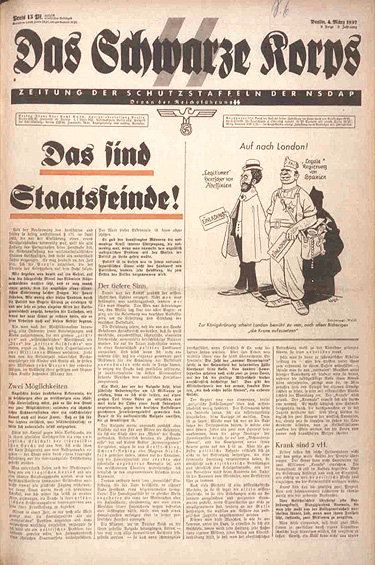
Type Weekly Newspaper
/ Founded 6 March 1935
/ Political alignment Nazism
/ Language German
/ Ceased publication 1945
/ Circulation 750,000 (as of 1944)
| Das Schwarze
Korps
([das ˈʃʋaʁtsə koːɐ̯]; German for "The Black Corps") was the official
newspaper of the Schutzstaffel (SS). This newspaper was published on
Wednesdays and distributed free of charge. All SS members were
encouraged to read it. The chief editor was SS leader Gunter
d'Alquen;[1] the publisher was Max Amann of the Franz-Eher-Verlag
publishing company. The paper was hostile to many groups, with frequent
articles condemning the Catholic Church, Jews, Communism, Freemasonry,
and others.[2] The newspaper was published in close co-operation with the Sicherheitsdienst (SD; Security Service), which had substantial editorial control. The first edition appeared on 6 March 1935.[3] In November of the same year, publication reached 200,000 and by 1944 had increased to 750,000.[3] The newspaper saw some distribution outside Germany.[a] |
ダス・シュヴァルツェ・コルプス
([das ˈʃʁtsə koˈ];
ドイツ語で「黒の軍団」の意)は、親衛隊の機関紙である。この新聞は毎週水曜日に発行され、無料で配布された。すべてのSS隊員に読むことが奨励された。
編集長はSSの指導者グンター・ダルケンであり[1]、発行人はフランツ=エーハー=フェルラーク出版社のマックス・アマンであった。この新聞は多くの団
体を敵視しており、カトリック教会、ユダヤ人、共産主義、フリーメーソンなどを非難する記事が頻繁に掲載されていた[2]。 この新聞は、編集の実質的な支配権を持っていたSD(Sicherheitsdienst:保安局)と緊密に協力して発行された。1935年3月6日に創 刊され[3]、同年11月には発行部数は20万部に達し、1944年には75万部に増加した[3]。 |
| History and contents Formed in 1935, Das Schwarze Korps was the official newspaper of the Schutzstaffel (SS).[1] The newspaper was created to be a defender of Nazism, as well as to disseminate and promote the ideological messages of their organization and its leader, Reichsführer-SS Heinrich Himmler.[5] The paper was used to reinforce Himmler's beliefs, to identify and attack elements within German society that he found unacceptable, to boost morale among members of the SS, to combat anything considered to be pernicious enemies within the Nazi state, and to encourage the racial doctrine that "pure-blooded Nordics must be bred"—which included promoting the idea that it was partially the responsibility of members of the "elite" SS corps to correspondingly produce "beautiful" illegitimate children.[6] Illegitimate births aside, marriage was depicted as an obligation to the state, part of the mechanism to establish a racially productive community in which individual happiness was of no importance.[7] In its inaugural edition, Das Schwarze Korps authors reiterated the Nordicist opinion of German scholars like Hans Günther—an important figure in official Nazi Party racial doctrine—that the "cradle of the Nordic peoples" was found "near the North Pole."[8] As the Olympic Games approached, the journal extolled sport as an expression of racial beauty, a means of strengthening the body, the mind, and physical contest as a form of preparation for war, echoing the doctrine of the SS itself.[9] On other occasions the paper served to inform its readers on the pseudo-scientific research Himmler commissioned to support his beliefs in the mystical powers of the ancient Germanic predecessors. In one edition, Das Schwarze Korps reported on the archaeological whereabouts (previously unknown) of Henry I's remains, claiming that, "scientific evidence has established that the remains discovered during excavations in the crypt of Quedlinburg cathedral are in fact those of Henry I."[10] Besides the esoteric pursuits of Himmler, the SS newspaper strongly criticized party leaders whose worldview differed from SS doctrine.[11] Carefully crafted articles gave SS men and the other readers an elitist image of the organization. This by means of information about the SS, its activities and successes, which were constantly scattered throughout the paper.[12] In place of the traditional aristocracy that existed in Germany and Europe proper, the SS advocated a culture of performance and merit. This included the articulation of new standards; for example, concerning the traditional title of "von" among the Junkers, Das Schwarze Korps quipped: The little word "von" no longer means to us the same thing it once did. We believe the nobility has the right to exist, not a nobility of class, not a nobility of birth or of property, but a nobility of achievement...the best from all classes...that is the nobility of the Third Reich.[13] Das Schwarze Korps routinely contained foreign news reports, analyses of threats, and theoretical essays on Nazi policies.[14] Praise for motherly women and families was contrasted against the women's movement; Nazi doctrine characterized women participating in politics as being too manly and called them "Amazons" so as to discredit them.[15] It had a strong pro-natalist slant, encouraging procreation or adoption.[16] Anti-clerical articles appeared in the paper, many of which attacked senior members of the clergy, each article part of an effort to "demolish the moral authority of the Catholic Church."[17] Christian concepts like original sin were described as "intolerable" ideas that were "incompatible" with Nordic man and the otherwise "heroic ideology" about Germanic blood.[18] The paper also covered foreign press attacks with instructions on how to refute them.[19] In accordance with doctrines of Blood and Soil, it spoke of the need to break up the aristocratic estates, although this was not implemented.[20] Historian Amy Carney described Das Schwarze Korps as "a conduit through which the SS was able to reveal its ambitions to the German people."[21][b] Das Schwarze Korps provided members of the SS with articles reminding them of their need to "be mindful of their family's biological heritage when marrying" and for general readers, the paper demonstrated "how dedicated its men were to their Führer and to the Reich and what an example they were setting for the entire Volk by adhering to the principles of eugenics."[21] Individual SS lives were given credence for their collective place in the framework of kith, kin, tribe, and the greater German Reich.[22] Prior to the passing of the 1935 Nuremberg Laws, the paper called for a law to ban Rassenschande or intercourse between Jews and Germans, as preferable to the extra-legal violence that the SA Stormtroopers indulged in against interracial couples;[23] after that edition, articles on the "Jewish Question" did not increase in number, but did grow more harsh in tone.[24] Judicial leniency was either criticized or ridiculed and a 1937 issue explained the obligation of lawyers to protect the "national community."[25] In the late 1930s, the paper featured an article written by physicist and Nobel Prize winner Johannes Stark, who argued that the racial, physical triumph of the Aryan over 'the Jew' would only be a "partial victory" unless Jewish ideas and sentiments were not also fully destroyed. Stark added that, "we also have to eradicate the Jewish spirit, whose blood can flow just as undisturbed today as before if its carriers hold beautiful Aryan passes."[26] In October 1938, an editorial argued that German Jews as "are also responsible for whatever world Jewry undertakes against Germany" and that they were also "liable for the damages which world Jewry inflicts and will inflict upon us."[27][28] A subsequent edition of Das Schwarze Korps communicated the harsh and foreboding message that if any single Jew harmed a German, they would all be held responsible, while another explicitly stated: "The day a murder weapon that is Jewish or bought by Jews rises against one of the leading men of Germany, there will be no more Jews in Germany!"[29] Immediately in the wake of the carnage of Kristallnacht, Nazi threats became reality and the SS-sponsored paper promoted ideas that anti-Semitism had been prevalent in all racially healthy peoples for thousands of years, but the Nazis were the only ones willing to take practical actions; meanwhile the periodical claimed the international community was full of hypocrites who refused to offer the Jews "safe refuge."[30] Additional propagandistic usage of the SS journal included the promotion of the cult of personality surrounding Adolf Hitler, as his portraits abounded within the text. A telling example of the adulation dedicated to the Nazi leader shows in the following extract from Das Schwarze Korps: The Führer is the highest gift to the nation. He is the German fulfilment. An artist who wants to render the Führer must be more than an artist. The entire German people and German eternity will stand silently in front of this work, filled with emotions to gain strength from it today and for all time. Holy is the art and the call to serve the people. Only the best may dare to render the Führer.[31] Such deification of Hitler accompanied by anti-Semitic propaganda made the editorial staff of the SS newspaper a responsible entity in the institutional framework of the Holocaust. The newspaper itself is an indictment against the Nazi Party collectively since it revealed even before the war that the SS was prepared to take radical action against the Jews.[30] Besides praising Hitler, the paper made specious claims against any perceived enemy; for example, Jews were portrayed as having an inclination towards Bolshevism (a widely known enemy of the Nazi state) in Das Schwarze Korps, indicated in the following excerpt from the 24 November 1938 edition: Least of all we do not want to see hundreds of thousands of impoverished Jews as a breeding-ground for Bolshevism and a recruiting base for the political and sub-humanity that, as a result of the selection process, is disintegrating on the margins of our own nationhood...In the event of such a development, we would face the harsh necessity of wiping out the Jewish underworld just as we are used to wiping out criminals in our orderly state: with fire and sword. The result would be the actual and definitive end of Jewry in Germany, its total extermination.[32][c] Hate-speech from the editors of the SS newspaper portended the Jews' later fate. Despite the sweeping statements made in the official SS-journal, SD chief Reinhard Heydrich—among the leading perpetrators of the Holocaust—rarely appears within its pages, as he thought it was "ill-organized and poorly written."[34] This did not stop Heydrich from using the paper to reinforce his message that any and all dissenters to the Anschluss with Austria were to be arrested, whether or not they wore a Nazi uniform.[35] Malleable to the political needs of the Nazi state, Das Schwarze Korps along with the Völkischer Beobachter were both used as propaganda mechanisms to promote the Molotov–Ribbentrop Pact between the Soviet Union and Germany in August 1939.[36] Commenting accordingly, the SS-newspaper optimistically asserted that the former tsarist empire "had originally been a Germanic state" that saved Prussia twice in the past, and the two countries "had always flourished when they were friends."[37][d] During the war, whenever the Waffen-SS would join the army in maneuvers, particularly at Hitler's behest, the instances were proudly reported in Das Schwarze Korps.[39] Deliberate propaganda efforts to bolster morale formed a notable portion of the content of the newspaper, especially in encouraging members of the SS and the public at large to remain prepared to report anyone who might oppose the war effort. For example, a 1943 article told the story of a soldier on leave from Stalingrad who overheard an old woman thought to be mentally impaired complaining about the war; the paper encouraged extreme action against people like this, calling them "cowardly traitors" and claiming in no uncertain terms that such persons deserve the same "harshness that we show toward the enemy, regardless of how stupid and innocuous we find them. This a war for our very survival. He who does not want our victory wants our defeat. He who wants our defeat wants our death."[40] Das Schwarze Korps was never officially dissolved and continued to publish until Germany's defeat in World War II, with its final edition coming out on March 29, 1945.[41] |
歴史と内容 1935年に結成されたダス・シュヴァルツェ・コルプスは、親衛隊の機関紙であった[1]。この新聞はナチズムの擁護者であると同時に、組織とその指導者 であるハインリヒ・ヒムラー親衛隊大総統のイデオロギー的メッセージを広め、宣伝するために作られた。 [この新聞は、ヒムラーの信念を強化するため、ドイツ社会の中で彼が受け入れがたいと考える要素を特定し攻撃するため、SS隊員の士気を高めるため、ナチ ス国家内の悪質な敵と見なされるものと戦うため、「純血の北欧人を育成しなければならない」という人種的教義を奨励するために使用された。 [6]。非嫡出子はさておき、結婚は国家に対する義務として描かれ、個人の幸福は重要ではない人種的に生産的な共同体を確立する仕組みの一部として描かれ た[7]。 その創刊号において、Das Schwarze Korpsの著者は、「北欧民族の発祥地」は「北極の近く」にあるという、ハンス・ギュンター(ナ チ党の公式人種教義の重要人物)のようなドイツの学者の北欧主義的意見を繰り返した。 「オリンピックが近づくにつれ、同誌はスポーツを人種の美の表現、肉体と精神を強化する手段、戦争への準備として肉体を競い合う手段として賞賛し、親衛隊 の教義と呼応させた[9]。ある版では、Das Schwarze Korpsはヘンリー一世の遺骨の考古学的所在(以前は不明)について報告し、「科学的証拠によって、クェドリンブルク大聖堂の地下聖堂で発掘中に発見さ れた遺骨が実際にヘンリー一世のものであることが証明された」と主張した[10]。 ヒムラーの難解な探求の他に、SS新聞はSSの教義と異なる世界観を持つ党指導者を強く批判した[11]。入念に練られた記事はSS隊員や他の読者に組織 のエリート主義的なイメージを与えた。これは、SSやその活動、成功に関する情報が常に紙面に散りばめられていたことによるものであった[12]。ドイツ やヨーロッパに存在した伝統的な貴族の代わりに、SSはパフォーマティビティと功績の文化を提唱した。これには新しい基準の明示も含まれていた。例えば、 ユンカースにおける「フォン」という伝統的な称号について、Das Schwarze Korpsはこう述べている: 例えば、ユンカースにおける伝統的な「フォン」という称号について、ダス・シュヴァルツェ・コルプスは次のように述べた。我々は貴族が存在する権利がある と信じている。階級の貴族でもなく、生まれや財産の貴族でもなく、功績の貴族......あらゆる階級からの最高の貴族......それが第三帝国の貴族 だ」[13]。 Das Schwarze Korps』には日常的に外国の報道、脅威の分析、ナチスの政策に関する理論的なエッセイが掲載されていた[14]。母性的な女性や家族に対する称賛は、 女性運動と対照的であった。ナチスの教義は、政治に参加する女性をあまりにも男らしいと評し、信用を失墜させるために「アマゾネス」と呼んだ[15]。 [16]反宗教的な記事が紙面に掲載され、その多くは聖職者の幹部を攻撃し、各記事は「カトリック教会の道徳的権威を取り壊す」努力の一環であった [17]。原罪のようなキリスト教の概念は、北欧の人間やゲルマンの血に関するそれ以外の「英雄的イデオロギー」とは「相容れない」「耐え難い」考えであ るとされた[18]。 血と土』の教義に従って、同紙は貴族の領地を解体する必要性を説いたが、これは実施されなかった[20]。 歴史家のエイミー・カーニーは、ダス・シュヴァルツェ・コルプスを「親衛隊がドイツ国民にその野望を明らかにするためのパイプ役」と評した。 「21][b]ダス・シュヴァルツェ・コルプスはSS隊員に対して、「結婚する際には一族の生物学的遺産に留意する」必要性を思い出させる記事を提供し、 一般読者に対しては、「その隊員たちが総統と帝国にどれほど献身的であり、優生学の原則を遵守することによって全ドイツ国民にどれほど模範を示している か」[21]を示した。個々のSSの生活は、血縁、親族、部族、そしてより大きなドイツ帝国という枠組みの中での集団的な位置づけとして信用された [22]。 1935年のニュルンベルク法の成立に先立ち、同紙はSAストームトルーパーが異人種間のカップルに対して行っていた非合法的な暴力よりも好ましいとし て、ユダヤ人とドイツ人の間の性交を禁止する法律(Rassenschande)を求めていた[23]。 1930年代後半、同紙は物理学者でノーベル賞受賞者のヨハネス・シュタルクが書いた記事を特集し、ユダヤ人の思想や感情も完全に破壊されない限り、アー リア人の「ユダヤ人」に対する人種的、物理的勝利は「部分的勝利」に過ぎないと主張した。シュタルクはさらに、「われわれはユダヤ人の精神も根絶しなけれ ばならない。その血は、その担い手が美しいアーリア人の峠を踏んでいれば、今日でも以前と同じように妨げられることなく流れることができる」と付け加えた [26]。1938年10月には、社説でドイツのユダヤ人は「世界のユダヤ人がドイツに対して行うあらゆる行為にも責任がある」とし、「世界のユダヤ人が われわれに与える、また与えるであろう損害にも責任がある」と主張した[27][28]。 その後の『Das Schwarze Korps』には、ユダヤ人一人でもドイツ人に危害を加えれば、彼ら全員が責任を負うという厳しく不吉なメッセージが伝えられ、別の版にははっきりとこう 書かれていた: 「ユダヤ人またはユダヤ人によって購入された凶器がドイツの有力者の一人に突きつけられた日には、ドイツからユダヤ人がいなくなる!」[29] クリスタルナハトの大虐殺の直後、ナチスの脅迫は現実のものとなり、親衛隊が後援するこの新聞は、反ユダヤ主義は何千年もの間、すべての人種的に健全な民 族に蔓延していたが、ナチスだけが現実的な行動を取ることを望んでいるという考えを宣伝した。 その一方で、定期刊行物は、国際社会はユダヤ人に「安全な避難場所」を提供することを拒む偽善者ばかりであると主張した。ナチスの指導者に捧げられた崇拝 の例として、『Das Schwarze Korps』からの次の抜粋が挙げられる: 総統は国民への最高の贈り物である。総統はドイツの成就である。総統を描こうとする芸術家は、芸術家以上の存在でなければならない。全ドイツ国民とドイツ の永遠は、この作品の前に静かに佇み、今日、そして未来永劫、この作品から力を得ようとする感情に満たされるだろう。聖なるものは芸術であり、人民への奉 仕の呼びかけである。最高の者だけが総統を表現する勇気を持つことができる[31]。 このような反ユダヤ宣伝にともなうヒトラーの神格化は、SS新聞の編集スタッフをホロコーストの制度的枠組みにおける責任ある存在にした。この新聞は、ナ チス親衛隊がユダヤ人に対して過激な行動をとる用意があることを戦前から明らかにしていたため、それ自体がナチス党に対する集団的な告発となっている [30]。ヒトラーを賛美するだけでなく、この新聞は認識されるあらゆる敵に対して思わせぶりな主張を展開した。たとえば、ユダヤ人はボリシェヴィズム (ナチス国家の敵として広く知られている)に傾倒していると『Das Schwarze Korps』紙に描かれており、1938年11月24日号からの次の抜粋に示されている: 少なくともわれわれは、何十万人もの貧困にあえぐユダヤ人がボリシェヴィズムの温床となり、選別の結果、われわれ自身の国民性の周縁で崩壊しつつある政治 的で亜人的なものの勧誘基地となるのを見たくはない......そのような事態が発生した場合、われわれは、われわれの秩序ある国家で犯罪者を一掃するの に慣れているように、ユダヤ人の裏社会を一掃する過酷な必要に直面するだろう。その結果、ドイツにおけるユダヤ人の実際の決定的な終焉、完全な絶滅がもた らされるであろう[32][c]。 SS新聞の編集者による憎悪の言葉は、ユダヤ人の後の運命を予言していた。公式のSS機関紙で大々的な発言がなされたにもかかわらず、ホロコーストの主要 な実行犯の一人であるSD長官ラインハルト・ハイドリヒは、この機関紙を「組織化されておらず、稚拙な文章」だと考えていたため、その紙面に登場すること はほとんどなかった[34]。それでもハイドリヒは、オーストリアとの合併に反対する者はナチスの制服を着ていようといまいと、すべて逮捕されるという メッセージを強化するためにこの機関紙を利用することを止めなかった[35]。 ナチス国家の政治的必要性に柔順であったDas Schwarze Korpsは、Völkischer Beobachterとともに、1939年8月にソ連とドイツの間で結ばれたモロトフ=リッベントロップ協定を促進するプロパガンダのメカニズムとして使 用された[36]。それに応じて、SS新聞は、旧ツァーリ帝国は過去に2度プロイセンを救った「もともとはゲルマン人国家であった」し、両国は「友好国で あったときには常に繁栄していた」と楽観的に主張した[37][d]。 戦時中、ヴァッフェン=SSが特にヒトラーの命令で軍隊の演習に参加するたびに、その様子は誇らしげに『Das Schwarze Korps』で報道された[39]。士気を高めるための意図的なプロパガンダの努力は、特にSSの隊員や一般市民に対して、戦争努力に反対する可能性のあ る人物は誰でも通報する用意があることを奨励するという点で、この新聞の内容の注目すべき部分を形成していた。例えば、1943年の記事では、スターリン グラードから休暇中の兵士が、精神障害者と思われる老女が戦争について不平を言っているのを耳にしたという話が紹介されている。同紙は、このような人々に 対する極端な行動を奨励し、彼らを「臆病な裏切り者」と呼び、そのような人々には「我々が敵に対して示すのと同じ厳しさが、彼らがいかに愚かで無害な人間 であろうと、当然与えられるべきだ」とはっきりと主張している。これはわれわれの生存をかけた戦争なのだ。我々の勝利を望まない者は、我々の敗北を望む。 われわれの敗北を望む者は、われわれの死を望む」[40]。 Das Schwarze Korpsは公式には解散せず、第二次世界大戦でドイツが敗北するまで発行を続け、最終版は1945年3月29日に発行された[41]。 |
| Other newspapers of Nazi Germany: Der Angriff ("The Attack"), Josef Goebbels' Berlin-based newspaper Berliner Arbeiterzeitung ("Berlin Workers Newspaper"), Gregor and Otto Strasser's newspaper, representing the Strasserite wing of the Nazi Party Illustrierter Beobachter ("Illustrated Observer"), illustrated companion to the Völkischer Beobachter Panzerbär ("The Panzer Bear"), a tabloid Nazi newspaper intended for the troops defending Berlin from the Red Army Das Reich, a weekly newspaper founded by Goebbels Der Stürmer ("The Stormer"), Julius Streicher's Nuremberg-based virulently antisemitic and frequently semi-pornographic newspaper Völkischer Beobachter ("People's Observer"), the official Nazi newspaper, published in Munich |
ナチス・ドイツの他の新聞 ヨゼフ・ゲッペルスがベルリンで発行していた新聞『デア・アングリフ』(『攻撃』)。 ベルリン労働者新聞(Berliner Arbeiterzeitung):グレゴールとオットー・シュトラッサーの新聞で、ナチ党のシュトラッサー派を代表する。 Illustrierter Beobachter(『イラストレイテッド・オブザーバー』)、『Völkischer Beobachter』の絵入り版。 Panzerbär (「パンツァーベアー」) 赤軍からベルリンを守る軍隊向けのタブロイド版ナチス新聞。 ゲッペルスが創刊した週刊紙『ダス・ライヒ』(Das Reich シュトゥルマー(『ストーマー』):ユリウス・シュトライヒャーがニュルンベルクを拠点に発行していた反ユダヤ主義的な新聞。 フォルキッシャー・ベオバハター(『人民の観察者』):ミュンヘンで発行されたナチスの機関紙 |
| Bibliography Adams, Peter (1992). Art of the Third Reich. London: Harry N. Abrams. ISBN 978-0810919129. Burleigh, Michael (2000). The Third Reich: A New History. New York: Hill and Wang. ISBN 978-0-80909-325-0. Bytwerk, Randall L. (2004). Bending Spines: The Propagandas of Nazi Germany and the German Democratic Republic. East Lansing, MI: Michigan State University Press. ISBN 978-0870137105. Carney, Amy (2014). "Das Schwarze Korps and the Validation of the SS Sippengemeinschaft". In Wolfgang Bialas; Lothar Fritze (eds.). Nazi Ideology and Ethics. Newcastle upon Tyne: Cambridge Scholars. pp. 323–342. ISBN 978-1-44385-422-1. Chapoutot, Johann (2016). Greeks, Romans, Germans: How the Nazis Usurped Europe's Classical Past. Oakland: University of California Press. ISBN 978-0-52029-297-0. Fischer, Klaus (1995). Nazi Germany: A New History. New York: Continuum. ISBN 978-0-82640-797-9. Gerwarth, Robert (2012). Hitler's Hangman: The Life of Heydrich. New Haven, CT: Yale University Press. ISBN 978-0-30018-772-4. Graber, G. S. (1978). The History of the SS. New York: D. McKay. ISBN 978-0-679-50754-3. Grunberger, Richard (1971). The 12-Year Reich: A Social History of Nazi Germany, 1933–1945. New York: Henry Holt and Company. ISBN 978-0-03-076435-6. Jenkins, Philip (1997). Hoods and Shirts: The Extreme Right in Pennsylvania, 1925–1950. Chapel Hill: University of North Carolina Press. ISBN 978-0-8078-2316-3. Kershaw, Ian (2008). Hitler: A Biography. New York: W. W. Norton & Company. ISBN 978-0-39306-757-6. Koonz, Claudia (2003). The Nazi Conscience. Cambridge, MA: Belknap Press of Harvard University Press. ISBN 978-0-674-01172-4. Longerich, Peter (2010). Holocaust: The Nazi Persecution and Murder of the Jews. Oxford; New York: Oxford University Press. ISBN 978-0-19-280436-5. Longerich, Peter (2012). Heinrich Himmler. Oxford and New York: Oxford University Press. ISBN 978-0199592326. Manvell, Roger; Fraenkel, Heinrich (1987). Heinrich Himmler. New York: Skyhorse Publishing. ISBN 978-1-85367-740-3. Moorhouse, Roger (2014). The Devil's Alliance: Hitler's Pact with Stalin, 1939–1941. New York: Basic Books. ISBN 978-0-46503-075-0. Overy, Richard (2004). The Dictators: Hitler's Germany, Stalin's Russia. London and New York: W.W. Norton & Company. ISBN 978-0-393-02030-4. Rees, Laurence (2017). The Holocaust: A New History. New York: PublicAffairs. ISBN 978-1-61039-844-2. Snyder, Louis L (1976). Encyclopedia of the Third Reich. London: Robert Hale. ISBN 978-1-56924-917-8. Stone, Dan (2016). "Nazi race ideologues". Patterns of Prejudice. 50 (4–5): 445–457. doi:10.1080/0031322x.2016.1243352. S2CID 151328044. Wistrich, Robert (2001). Hitler and the Holocaust. New York: Modern Library Chronicles. ISBN 978-0-679-64222-0. Zeck, Mario (2002). Das Schwarze Korps: Geschichte und Gestalt des Organs der Reichsfuhrung SS (in German). Tübingen: Niemeyer Verlag. ISBN 978-3-484-34051-0. Zentner, Christian; Bedürftig, Friedemann (1991). The Encyclopedia of the Third Reich. New York: Macmillan Publishing. ISBN 978-0-02-897500-9. Ziegler, Herbert F. (1989). Nazi Germany's New Aristocracy: The SS Leadership, 1925–1939. Princeton, NJ: Princeton University Press. ISBN 0-691-05577-7. Combs, William L. Voice of the SS: A History of the SS Journal Das Schwarze Korps. New York: Peter Lang, 1986. ISBN 0-8204-0083-1. Kositza, Christian: Das Schwarze Korps. Die Zeitung der Schutzstaffeln der NSDAP. Organ der Reichsführung SS' über den Judeozid. Norderstedt 2013. ISBN 978-3-8482-2882-9. Kovačević, Philip. Der Balkan aus der Sicht der SS. Rezeption und Konstruktion des Balkanraumes in der SS-Zeitschrift „Das Schwarze Korps“. München: AVM, 2009. ISBN 978-3-86924-843-1. Stone, Dan. "Nazi Race Ideologues." Patterns of Prejudice 50.4-5 (2016) |
参考文献 アダムス、ピーター(1992年)。第三帝国の芸術。ロンドン:ハリー・N・エイブラムス。ISBN 978-0810919129。 バーレイ、マイケル(2000年)。第三帝国:新たな歴史。ニューヨーク:ヒル・アンド・ワング。ISBN 978-0-80909-325-0。 Bytwerk, Randall L. (2004). Bending Spines: The Propagandas of Nazi Germany and the German Democratic Republic. East Lansing, MI: Michigan State University Press. ISBN 978-0870137105. Carney, Amy (2014). 「Das Schwarze Korps and the Validation of the SS Sippengemeinschaft」. In Wolfgang Bialas; Lothar Fritze (eds.). Nazi Ideology and Ethics. Newcastle upon Tyne: Cambridge Scholars. pp. 323–342. ISBN 978-1-44385-422-1. チャプート(2016年)。『ギリシア人、ローマ人、ドイツ人:ナチスがヨーロッパの古典的過去を奪取した方法』オークランド:カリフォルニア大学出版。 ISBN 978-0-52029-297-0。 フィッシャー、クラウス(1995年)。ナチス・ドイツ:新たな歴史。ニューヨーク:コンティニュアム。ISBN 978-0-82640-797-9。 ゲルワース、ロバート(2012年)。ヒトラーの腹心:ハイドリヒの生涯。コネチカット州ニューヘイブン:イェール大学出版。ISBN 978-0-30018-772-4。 グラバー、G. S. (1978年). 『SSの歴史』. ニューヨーク: D. マッケイ. ISBN 978-0-679-50754-3. Grunberger, Richard (1971). The 12-Year Reich: A Social History of Nazi Germany, 1933–1945. New York: Henry Holt and Company. ISBN 978-0-03-076435-6. ジェンキンズ、フィリップ(1997年)。Hoods and Shirts: The Extreme Right in Pennsylvania, 1925–1950. チャペルヒル:ノースカロライナ大学出版。ISBN 978-0-8078-2316-3. カーショウ、イアン(2008年)。『ヒトラー:伝記』。ニューヨーク:W. W. Norton & Company。ISBN 978-0-39306-757-6。 クーンツ、クラウディア(2003年)。『ナチスの良心』。ケンブリッジ、マサチューセッツ:Belknap Press of Harvard University Press。ISBN 978-0-674-01172-4。 ロングリッチ、ピーター(2010年)。ホロコースト:ナチスによるユダヤ人の迫害と虐殺。オックスフォード、ニューヨーク:オックスフォード大学出版 局。ISBN 978-0-19-280436-5。 ロングリッチ、ピーター(2012年)。ハインリヒ・ヒムラー。オックスフォード、ニューヨーク:オックスフォード大学出版局。ISBN 978-0199592326。 マンヴェル、ロジャー; フランケル、ハインリヒ (1987年). ハインリヒ・ヒムラー. ニューヨーク: Skyhorse Publishing. ISBN 978-1-85367-740-3. ムーアハウス、ロジャー (2014年). 悪魔の同盟: ヒトラーとスターリンの1939年から1941年の密約. ニューヨーク: ベーシック・ブックス。ISBN 978-0-46503-075-0。 オーバーイー、リチャード(2004年)。『独裁者たち:ヒトラーのドイツ、スターリンのロシア』。ロンドンおよびニューヨーク:W.W. ノートン・アンド・カンパニー。ISBN 978-0-393-02030-4。 リース、ローレンス(2017年)。『ホロコースト:新たな歴史』。ニューヨーク:パブリックアフェアーズ。ISBN 978-1-61039-844-2。 スナイダー、ルイス・L(1976年)。『第三帝国事典』。ロンドン:ロバート・ヘイル。ISBN 978-1-56924-917-8。 ストーン、ダン(2016年)。「ナチスの人種イデオローグ」。『偏見のパターン』第50巻第4-5号、445-457ページ。doi: 10.1080/0031322x.2016.1243352。S2CID 151328044。 Wistrich, Robert (2001). Hitler and the Holocaust. New York: Modern Library Chronicles. ISBN 978-0-679-64222-0. ゼック、マリオ(2002年)。『黒い旅団:国家社会主義ドイツ労働者党の機関誌の歴史と形態』(ドイツ語)。テュービンゲン:ニーメイヤー出版。 ISBN 978-3-484-34051-0。 ゼントナー、クリスチャン、ベドゥルンギ、フリードマン(1991年)。『第三帝国事典』。ニューヨーク: マクミラン出版。ISBN 978-0-02-897500-9。 ジーグラー、ハーバート F. (1989年)。ナチス・ドイツの新しい貴族階級:SS指導部、1925年~1939年。プリンストン、ニュージャージー州:プリンストン大学出版。 ISBN 0-691-05577-7。 Combs, William L. 親衛隊の声:親衛隊の歴史ジャーナル『Das Schwarze Korps』。ニューヨーク:Peter Lang、1986年。ISBN 0-8204-0083-1。 Kositza, Christian: Das Schwarze Korps. Die Zeitung der Schutzstaffeln der NSDAP. Organ der Reichsführung SS' über den Judeozid. Norderstedt 2013. ISBN 978-3-8482-2882-9. コヴァチェヴィッチ、フィリップ。SSの目を通して見たバルカン。SS機関誌『ダス・シュヴァルツェ・コルプス』におけるバルカン地域の受容と構築。ミュ ンヘン:AVM、2009年。ISBN 978-3-86924-843-1。 ストーン、ダン。「ナチスの人種イデオローグ。」『偏見のパターン』50.4-5(2016 |
| https://en.wikipedia.org/wiki/Das_Schwarze_Korps |
リンク
文献
その他の情報
Copyleft, CC, Mitzub'ixi Quq Chi'j, 1996-2099
Copyleft, CC, Mitzub'ixi Quq Chi'j, 1996-2099
☆
 ☆
☆